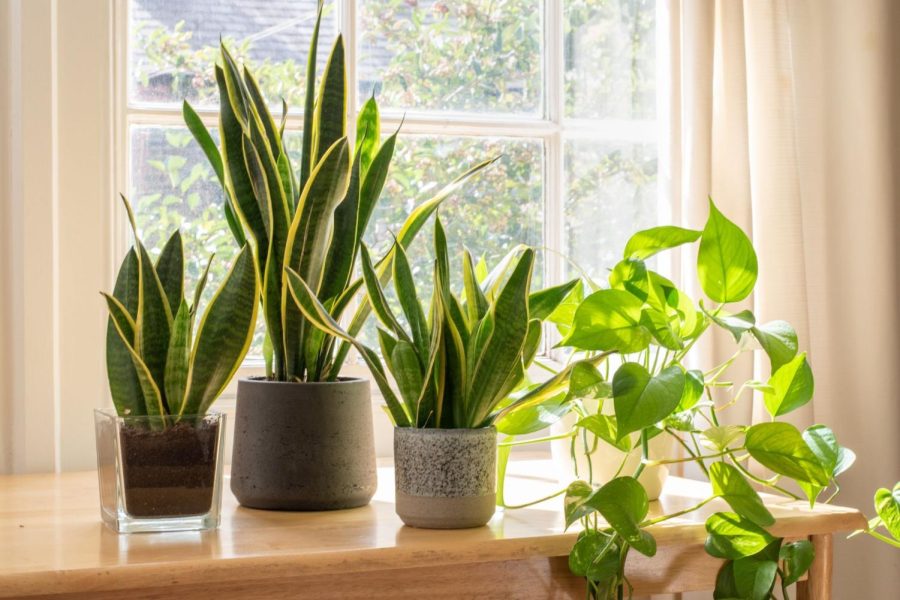Dorm-Friendly Houseplants for Beginners
Looking to add a pop of color to your dorm? Want a cheap way to purify the air and reduce stress levels? Searching for a new hobby that doesn’t require leaving your room? If you answered ‘yes’ to any of these questions, houseplants may be the solution for you. “Plant parenthood” has become extremely popular in recent years because of its affordability and convenience, particularly during the COVID-19 pandemic. The trend has even inspired its own tag on TikTok: #planttok. If you’re looking to purchase your first houseplant or just refine your plant care skills, this is the article for you. Keep reading for the top five houseplants for beginners, as well as a list of tips and tricks for developing a green thumb.

Best Plant for Low Light: Snake Plant
The Sansevieria trifasciata, commonly known as the snake plant, is a beginner-friendly plant that can grow in low to medium light. The snake plant is also hardy when it comes to watering; it can go several weeks without being watered. Snake plants are known for their stiff, upright blades that are variegated with shades of green and yellow. Common varieties include the cylindrical snake plant, the hahnii snake plant, the Laurentii snake plant, and the whale fin. Given the right conditions, snake plants can produce flower stalks with honeysuckle-like blooms, typically in the spring. While snake plant flowers are typically rare, you can always count on sansevierias for their rich green foliage.

Best Plant for Direct Sunlight: Cacti
Given their desert origins, it is unsurprising that cacti of most varieties thrive in direct sunlight. Cacti are generally one of the cheapest plants to purchase and can be found in stores like Walmart or Lowe’s for just a few dollars. While the Cactaceae family contains over 1700 species, the varieties you will likely find in stores or greenhouses include the golden barrel, bunny ears, and lemon ball cactus. Place your cacti on a sunny windowsill and ensure that the soil is well-draining for best results. Keep an eye out for stunning mid-summer blooms!

Best Plant That Tolerates Overwatering: Peace Lily
If you tend to have a heavy hand while watering your plants, the peace lily plant (Spathiphyllum) may be your new best friend. Peace lilies, characterized by their wide waxy leaves and round white blooms, enjoy a thorough weekly watering. If a peace lily needs water, its leaves will droop considerably until its soil is remoisturized. Peace lilies are one of the few houseplants that enjoy consistently moist (but not drenched) soil. Peace lilies can live in low-medium light. Placing your peace lily in high indirect light will require more frequent watering.

Best Plant That Tolerates Underwatering: ZZ Plant
Zamioculcas zamiifolia, or the ZZ Plant, is perfect for those who may be forgetful or inconsistent with watering their plants. The ZZ Plant is an attractive and fast grower with its shiny, oval-shaped leaves that shoot upwards. ZZ plants should be watered every 2-3 weeks, or after the soil has dried out completely. Try bottom-watering (placing the pot in a bowl of water) with this plant, as it helps develop a better root system and allows the plant to only take up as much water as it needs. ZZ plants enjoy bright indirect light (such as sunshine through a sheer curtain) and do particularly well in the fluorescent lighting of dorms and office buildings.

Best Climbing/Trailing Plant: Pothos
If you’re interested in leafy vines that can climb or trail, consider the pothos plant (Epipremnum aureum). Pothos plants (which are often confused with Philodendrons) have waxy, heart-shaped leaves that can be variegated with yellow or white. These plants can be wrapped around a moss pole or other stake for climbing or left to grow downwards into an eccentric trailing plant. Pothos plants are especially easy to propagate: to make new plants from the original, cut off a leaf or two below the root node, and place them in water. Within 1-2 weeks, the cuttings will produce roots and can be planted. Pothos enjoy bright, indirect light and biweekly watering. Common varieties include the golden, neon, n’joy, and marble queen pothos.
Tips/Tricks for Plant Parents
Once you’ve identified your dream houseplant(s), consider these tips and tricks to make your plant experience a success.
- Start small. Avoid purchasing large plants (which are generally more expensive) and
instead opt for plants in 4-inch or 6-inch pots. If you employ good plant care skills, you
will soon have a large plant of your own! - Download apps to help you learn. Apps like Planta (which sets up watering cycles for
your plants and sends reminders), GardenAnswers (which can be used to identify
unknown plants), or the r/Houseplants thread on Reddit can be useful for plant owners at
all skill levels. - Invest in a moisture tester. While you may feel confident that you know your plant’s
moisture level, it is best to double-check using a moisture meter. These devices consist of
two prongs, which are inserted into the soil and rate its moisture on a scale of 1-10 (1
being dry, 10 being wet). Based on the readings from your moisture meter, you can make
better-informed decisions of when to water your plant and how much water to give them. - Watch out for pests. Common threats to plants include mealybugs, spider mites, and
fungus gnats. If you notice that your plant(s) have an infestation, isolate the plant
immediately and begin treatment using a natural substance like neem oil. - Shop at local greenhouses, when possible. This helps ensure that you receive high-quality
plants and lessens the risk of pests or root rot.
The most important tip for plant care is this: enjoy the process. Tending to plants should be a relaxing and enriching experience, so don’t forget to prioritize your mental health as you embark on the journey of plant parenthood. Best of luck, plant parents!













